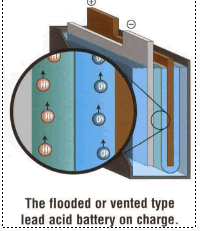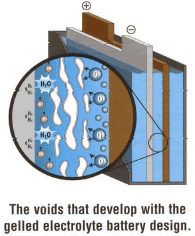ResourcesCompare Battery Types
Today, there are three distinct types of lead acid batteries manufactured and any one type can be designed and built for either starting or deep cycle applications. These types are flooded acid, gelled acid, and Advanced AGM (Absorbed Glass Mat). There are various quality levels available in each type. Price is dependent upon the perceived quality as well as the product design, processing, and manufacturing costs. This includes the amount of lead, methods of pasting and curing the plates, degree and type of inter-plate insulation, quality of the case, and the sealing method used. Generally, high quality means higher cost.
The oldest types of lead acid batteries are flooded cell types. These have been around for decades. The liquid sulfuric acid solution in these batteries has destroyed more than a few sets of clothes and pieces of RV gear. They generate and vent dangerous explosive gases, acid “mist” during charging, corrode their terminals, often-acid damage surrounding surfaces, and require regular watering. They are the least expensive type and therefore are the choice of many RV owners.


The next types of batteries are gelled acid (Electrolyte) designs. They were introduced to American RVs by Sonnenschein of Germany over 30 years ago and widely touted for their increased efficiency and designed safety features. Their acid is immobilized by adding “fumed” silica to the sulfuric acid solution and then sealing the battery. They internally recombine most of the gases (hydrogen and oxygen) generated during charging and are maintenance free. Gelled electrolyte battery designs are generally quite old and few engineering options are left to improve them. Gel electrolyte is highly viscous and during charge and discharge the gel can develop voids or cracks. These impede acid flow and result in the loss of battery capacity. Also the gelled mixture can liquefy upon charge due to the shearing action of gassing (this property is called thixotropic”). After termination of charge, it can take an hour for the acid to gel again. During this time liquid is moving and the battery can leak if any opening has developed. Last, gel batteries may store hydrogen gas that has not recombined. When overcharging causes a gel battery’s vent caps to open, explosive gasses may be vented into the battery compartment. This vented hydrogen has caused a number of “fast failures” or battery explosions.
The latest and most advanced battery technology is Advanced AGM, which was developed to provide increased safety, efficiency, and durability over all existing battery types. In Advanced AGM batteries the acid is absorbed into a very fine glass mat that is never free to slosh around.
Secondly, since the plates are kept only “moist” with electrolyte, gas recombination is more efficient. (99% AGM). Thirdly, since the AGM material has an extremely low electrical resistance, the battery delivers much higher power and efficiency than the other two types. Last, Advanced AGM batteries offer exceptional life cycles.
Recombinant gas technology was brought to state-of the-art status at Concorde Battery Corporation, one of the worlds leading suppliers of sealed aviation batteries. The first AGM, “Air Worthy” batteries were delivered to the U.S. Military in 1985 and today are used on the Stealth Bomber, F- 18 fighter jet, and in other demanding military applications. The heavier “fat plate” “Lifelines” were introduced in 1989. Today, “Lifelines” are the most advanced recreational vehicle batteries manufactured in the world. They are subject to the same high standards of design and manufacture as required by FAA and Military Specifications. Additionally, “Lifeline” is the only Advanced AGM product available in standard battery configuration and sizes. They are standard equipment on many U.S. Navy crafts, fine yachts built by Pacific Seacraft, Island Packet, and Hinckley Company to mention three, and quality coaches built by such companies as Vision Coach, Royal Coach and Vantare Coach.

A Comparison of the three types of batteries:
Complicated graphs and comparison charts are not necessary to compare the three battery types. Consider:
Safety
Batteries can be dangerous. They store a tremendous amount of energy, create explosive gas during charge and discharge, and contain dangerous chemicals. Some designs and construction techniques are safer than others are. Both Gel and Lifeline Advanced AGM are sealed batteries that use recombinant gas technology. Lifeline Advanced AGM is more efficient in the AGM process and completes its gas recombination near the plates. In fact, they are the only RV batteries to pass the rigid MILITARY-SPECIFICATION for non-gassing even during severe overcharge. A recent Coast Guard Advisory warned all users of Gel recombinant gas batteries to install automatic temperature compensated voltage regulators to prevent explosions associated with their overcharging. Flooded batteries will spew acid, will definitely spill and leak if tipped over, and they generate dangerous and noxious explosive gases. “Lifeline” Advanced AGM batteries are best at protecting both equipment and passengers.
Longevity
All batteries die. The number of cycles it takes to kill them is a function of the type and quality of the battery. When cycled at between 25 to 40 percent depth of discharge (recommended deep cycle use) “Lifeline “Advanced AGM batteries will normally easily outlast the other two types.
Durability
Some battery designs are simply more durable than others are. They are more forgiving in abusive conditions, i.e.; they are less susceptible to vibration and shock damage, over charging, and deeper discharge damage. Gel acid batteries are the most likely to suffer irreversible damage from overcharging. Flooded acid batteries are the most likely to suffer from internal shorting and vibration damage. Lifeline Advanced AGM batteries are more durable and can withstand severe vibration, shocks, and fast charging.
Efficiency
This comparison is critical. Internal resistance of a battery denotes its overall charge/discharge efficiency, its ability to deliver high cranking currents without significant drops in voltage, and is a measure of how well it has been designed and manufactured. Internal resistance in NiCad batteries is approximately 40%, i.e., you need to charge a NiCad 140% of its rated capacity to have it fully charged. For flooded wet batteries, internal resistance can be as high as 26%, which is the charging current lost to gassing, or breaking up of water. Gel acid batteries are better at only approximately 16% internal resistance and require only roughly 116% of rated capacity to be fully charged. Lifeline Advanced AGM has the lowest internal resistance of any battery manufactured only 2 percent. This allows Lifelines to be charged much faster if needed and also to deliver higher power when required. Owners using high output alternators, operating inverter banks, or relying on solar panels can benefit significantly when using Lifeline Advanced AGM batteries with their equipment. “Lifelines” are more efficient!!
Battery Measurements
Most buyers like to make comparisons by using various specifications and measurements. A few common comparison criteria are Cold Cranking Amps or CCA, which is a clear indicator of a battery’s ability to start an engine. Reserve Minutes depict a battery’s ability to deliver current at steady rates from a fully charged condition down to 10.5 volts and are expressed in minutes, i.e., reserve minutes at 25 amp discharge. Life Cycles are used to measure longevity or how many times a battery can be discharged in its life time at set levels. We compared one of each battery type against various measurements and standards using data published data, as it was available. In our comparison we selected only top quality products; Advanced AGM Lifeline, Sea Gel and Sea Volt. The Group 27 size comparison figures are printed below. An independent comparison of GRP-27 batteries was completed by Cruising World Magazine in June of 1997. Advanced AGM won this comparison.
